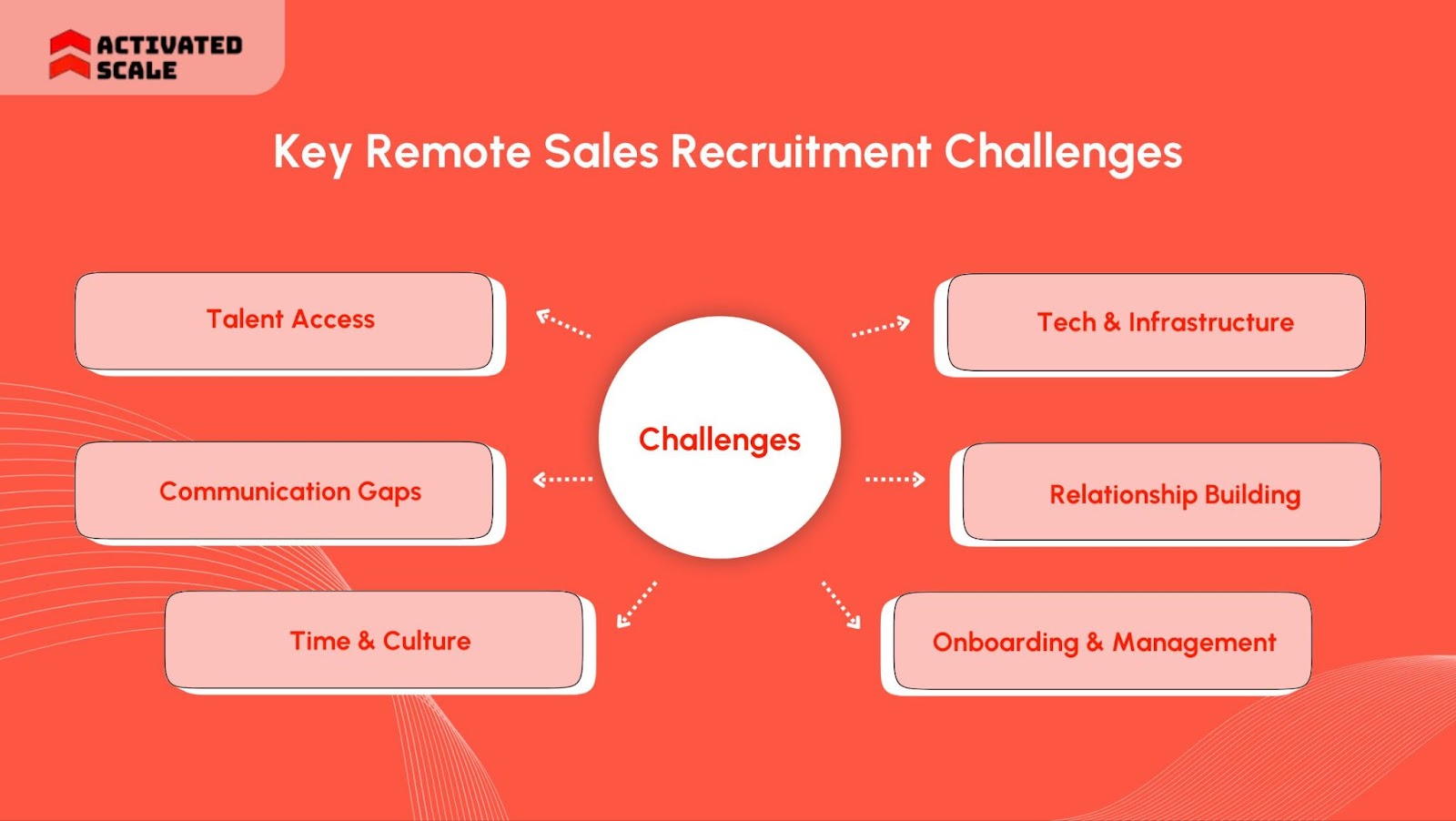Since in the U.S., a 5-day office culture is not mandatory anymore, remote sales have significantly increased. It has also scaled in 2025, but so have the risks of remote sales.
If you’ve faced ghosting, weak performance, or culture mismatches, it’s a common situation. These are common headaches for companies that hire remote sales talent too fast or with outdated methods.
Each quarter, we partner with emerging and growing companies solving this specific issue. So, we can understand the issues related to remote hiring.
In this blog, you’ll learn about the real-world remote sales recruitment challenges to expect. We will also share strategies that can help you fix the gaps.
At a Glance:
- Remote sales recruitment requires candidates to demonstrate self-management, digital tool proficiency, and strong asynchronous communication skills.
- Sourcing talent globally offers opportunities but comes with fierce competition, requiring specialized recruitment tools.
- Communication gaps, due to a lack of non-verbal cues, can create friction. Tools like Zoom and Typeform are essential.
- Tracking key metrics like time to hire, quota attainment, and 30/60/90-day performance ensures long-term success.
How Does Remote Sales Recruitment Work?
Remote sales recruitment flips the traditional hiring model. Instead of face-to-face meetings, everything from sourcing to onboarding happens online. This shift means recruiters must adapt their evaluation methods.
For instance, candidates are tested for their ability to perform independently without daily office oversight.
That’s why remote sales roles require agility. These candidates must grow in fast-moving environments where their daily activities are less obvious to managers.
Benefits of hiring remote sales professionals include:
- Access to global talent without location constraints
- Cost savings on infrastructure, travel, and salaries in lower-cost regions
- Faster hiring cycles with automation and virtual assessments
- Around-the-clock coverage via distributed teams
- Improved diversity and flexibility in hiring decisions
However, even with the right tools and frameworks in place, challenges often arise that can derail the process.
Let’s take a look at the key obstacles companies face when recruiting for remote sales positions.
Also Read: The Art of Spotting Sales Talent: Key Traits to Look for in A High-Performing Sales Team
6 Key Remote Sales Recruitment Challenges With Solutions

Despite the flexibility and global talent pool remote sales recruitment offers, companies often struggle with a few specific hurdles.
These challenges can slow down hiring, lead to mismatches, or even create retention risks.
Addressing these challenges head-on is key to creating a smooth and efficient remote sales recruitment process. Here’s what you need to know:
1. Talent Shortage and Access
In 2025, 77% of professionals find themselves more productive in remote work. This belief is strong enough to create the right talent shortage in the market. Many regions struggle with the availability of highly skilled remote salespeople.
Companies look for experienced professionals who can quickly adapt to the remote work environment. That’s why this issue becomes more pronounced as many local job markets are saturated with underqualified talent.
Solution:
- Tap into niche recruitment platforms like the Activated Scale platform and curate talent networks designed for remote work.
- You can also adopt Contract-to-Hire Sales Recruiting service. This can reduce hiring risks while testing the performance of new hires in real-world scenarios.
2. Communication Gaps
Effective communication is crucial for remote sales teams. However, 86% of employees struggle with communication gaps in their conversations.
So, the shift from in-person interactions to virtual communication creates barriers in understanding tone, urgency, and context.
The lack of non-verbal cues makes it challenging to gauge a candidate’s true personality during the hiring process.
Moreover, setting unclear expectations due to a communication gap adds complexity to the recruitment process.
Solution:
- Implement tools like async video platforms like Willo Video to evaluate communication skills in real-time. In this way, candidates can respond at their own pace and in their environment.
3. Time Zone and Cultural Differences
Remote teams often span multiple continents, leading to time zone challenges and cultural differences. Even a one-hour gap in time zones can cause significant delays in response times and scheduling challenges. These delays affect sales cycles, performance metrics, and even day-to-day communication.
Cultural differences can lead to misunderstanding or misalignment, particularly in international negotiations.
Salespeople from different regions may have different approaches to customer interactions, negotiation tactics, or expectations of formality in communication.
Solution:
- Use tools like Calendly or Doodle to coordinate interviews and meetings across time zones.
- To address cultural differences, invest in cultural sensitivity training for your sales teams. This can help mitigate misunderstandings in negotiations and customer interactions.
4 .Technology and Infrastructure
The effectiveness of a remote sales team depends heavily on technology. Without the right tools and reliable connectivity, remote sales teams cannot perform at their best.
Interviewees may face challenges during virtual interviews due to incompatible software. The lack of automation tools and ATS (applicant tracking system) integrations makes it harder to scale the recruitment process effectively.
Solution:
- Ensure both your hiring managers and candidates are equipped with the necessary tools. For example, choose TestGorilla for pre-screening, Loom for onboarding, or Slack for day-to-day communication.
- Integrating ATS systems like Lever or Greenhouse helps reduce the risk of technical disruptions.
5. Relationship Building and Engagement
Remote work can often lead to feelings of isolation, which in turn affects team engagement and retention. At least 87% of remote employees feel disconnected from their teams, impacting morale and productivity.
Building strong relationships with new hires and promoting a sense of belonging can be difficult without physical interactions.
Furthermore, keep new remote hires engaged, especially when they are working across different geographies.
Solution:
- Use mentorship programs and clear communication protocols to maintain engagement and build relationships.
- Tools like Notion or Trello can be used for organizing and tracking progress while ensuring that everyone is on the same page.
6. Onboarding and Management
Onboarding remote employees is far from straightforward. 20% of employees tend to quit within the first 45 days of recruitment due to unsatisfactory onboarding. This happens because new hires miss out on the one-on-one discussion with colleagues.
It is essential to learn the company culture and build relationships with colleagues. Distractions in home offices can also hinder new hires' ability to focus during their onboarding process.
Additionally, managing remote teams requires a different leadership style, one that balances autonomy with consistent guidance.
Solution
- Provide virtual tours of the office, introduce new hires to key team members, and set clear expectations through 30/60/90-day plans.
- Equip new hires with the tools they need from day one, ensuring they have access to all systems and platforms.
To overcome these challenges, consider using Activated Scale’s Fractional Selling service. This allows you to hire professionals and assess their performance based on their work in a trial period.
While these challenges can be daunting, the right strategies and tools can help you tackle them effectively.
Recruitment Strategy to Overcome Remote Hiring Challenges

It’s essential to have a step-by-step framework to source, screen, and onboard candidates efficiently during remote hiring. Here’s a breakdown of a proven recruitment strategy designed to tackle the issues discussed earlier:
Step 1: Discovery call
The first step is identifying the specific skills and traits needed for the remote sales role. In the discovery phase, outline the target personas and what characteristics make an ideal candidate for your team.
Pay close attention to dealbreaker traits such as the ability to work independently, proficiency with remote sales tools, and adaptability. This step helps you define the right candidate profile from the outset.
Use the Activated Scale to search for candidates who match the ideal persona criteria, filtering by key skills and experience.
Here’s what we offer:
1. Contract-to-Hire Sales Recruiting
This service allows businesses to bring in vetted sales professionals on a flexible, trial basis. This is especially beneficial when building a remote sales team, where you want to focus on performance and cultural perspective.
2. Fractional Selling
Scaling your remote sales team quickly doesn’t always require hiring full-time staff. With our service, Activated Scale offers access to experienced sales development representatives (SDRs) and account executives (AEs) on a fractional basis.
These seasoned sales professionals can help test out go-to-market (GTM) strategies without the need to make long-term commitments.
3. Fractional Sales Leadership
When you need strategic direction for your remote sales team, this provides access to senior talent on a part-time basis. Activated Scale brings in experienced fractional VPs of sales who can implement the right tools for your team.
Ready to scale your sales team and overcome remote sales recruitment challenges? Learn more about Activated Scale’s services by scheduling a call.
Step 2: Screening
Screening remote candidates requires assessing their skills and their ability to thrive in a remote environment.
For remote-specific assessments, integrate Typeform to administer asynchronous video-based tasks where candidates respond to role-play situations.
Using this, you get a clearer picture of their abilities without having to rely solely on traditional interviews.
Step 3: Interviews
Remote interviews require candidates to showcase their ability to perform in real-world conditions. To simulate real-life scenarios, run panel-based simulations using video conferencing platforms like Zoom or Google Meet.
Ask candidates to participate in live roleplays, conduct sales presentations, or showcase tool familiarity.
Otter.ai can also be integrated to transcribe conversations in real-time. It provides you with written records for deeper post-interview analysis.
Step 4: Measure Key Performance Indicators for Continuous Improvement
Tracking performance is essential when scaling remote sales teams. The following key metrics will help you stay aligned with your goals:
1. Time to Hire
This metric tracks the time from posting a job opening to extending an offer. You can assess how efficiently your recruitment process is functioning and identify bottlenecks in your sourcing stages.
2. Quota Attainment
Monitoring quota attainment at 3, 6, and 12 months is a key indicator of how well your new hires are performing in the remote sales environment.
Tracking this metric gives you an idea of whether your hires are meeting their sales targets as per your expectations.
3. Candidate NPS (Net Promoter Score)
Candidate satisfaction is just as important as the candidates’ sales performance. You can ask for feedback on how likely they are to recommend your hiring process to others.
This feedback helps you refine the recruitment experience to make it more attractive for future candidates.
4. Retention After 90 Days
Retention is a strong indicator of whether your remote hiring process is effective. Tracking retention rates after 90 days allows you to determine whether hired candidates are integrating well into the remote culture.
Incorporating these strategic services ensures that your remote sales team is set up for long-term success.
Read Also: 10 Strategies to Generate Sales Leads for Your Business
Conclusion
From talent shortages to managing cultural differences, remote sales recruitment challenges require more than just traditional approaches.
You need a thoughtful, adaptable strategy that considers the specific needs of your business.
Using the right tools and frameworks, you can build a sales team that will provide you with success in the long run. At Activated Scale, we offer solutions that allow you to minimize the risks associated with remote hiring.
Need help handling the complexities of remote sales recruitment? Book a call today to learn how we can help you lead a high-performing remote sales team.
FAQs
1. How can I ensure remote sales candidates are truly motivated and self-sufficient?
During the recruitment process, ask candidates to share examples of how they’ve managed remote work challenges in the past. Additionally, consider using video assessments to evaluate their communication skills and how well they present without immediate feedback. This helps you gauge their ability to work independently and stay motivated without direct oversight.
2. What role does sales technology play in remote sales recruitment?
Sales technology is critical for both recruiting and managing remote sales teams. It helps automate candidate sourcing, simplify communication, and track performance.
Tools like Salesforce and HubSpot CRM ensure that remote teams remain connected and productive.
3. Can a remote sales team be as effective as an in-office team?
Yes, with the right processes, tools, and leadership, a remote sales team can perform just as well as an in-office team. Consistent communication through platforms like Slack and setting clear goals can ensure that remote teams remain effective in meeting sales targets.
4. How do I handle underperformance in a remote sales team?
Address underperformance by setting clear performance benchmarks during the hiring process and revisiting those expectations regularly. Use tools like Salesloft for tracking individual metrics and use regular check-ins to identify challenges.
If necessary, bring in Fractional Sales Leadership to provide additional guidance to boost performance across the team.
The Ultimate Guide to Hiring a Salesperson!
Get the step-by-step guide to hiring, onboarding, and ensuring success!
_edi.png)




